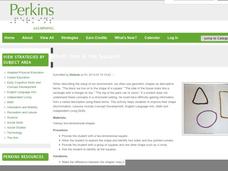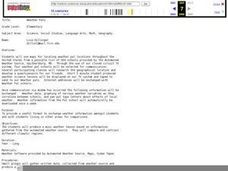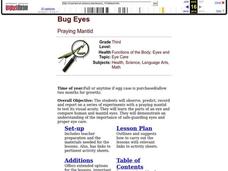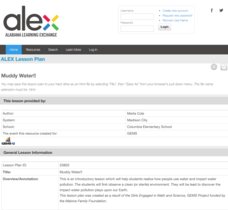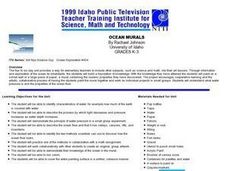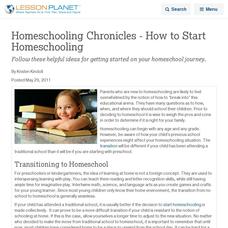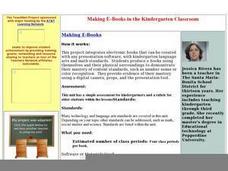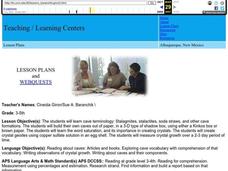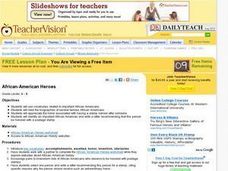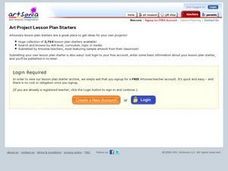Perkins School for the Blind
Circle Time
Oftentimes children or teens with one or more disability are reluctant to participate in whole-group activities. Foster good participation, verbal expression, and social skills through daily circle time activities. Each day you and...
Perkins School for the Blind
Which One is the Square?
Children who are blind need to constantly be engaged in building conceptual understandings of the world around them. This activity will help them grasp the concept of shape, identify shapes, and consider shapes as they are used to...
Curated OER
Weather Pals
Students study maps of the United States to locate weather pals from a list of schools. They communicate with Weather Pal schools through the use of closed circuit TV. Using weather data collected in their area, they exchange the...
Curated OER
Developing Relationships with Older People
Young scholars read books and view movies about older people. They write a questionnaire to interview older people at a retirement center, interview the people, record their information on graphs, and write follow-up letters.
Curated OER
Museums in the Classroom Pumpkin Project
Students identify the 5 stages in the life cycle of a pumpkin. They create a model showing the correct order of pumpkin life stages. They explain a pumpkin's life cycle to a partner, using their model.
Alabama Learning Exchange
The Solar System
Learners explore the Solar System. In this cross-curriculum space instructional activity, students identify the planets, name them in order according to distance from the sun, and describe major characteristics of each planet. Learners...
Curated OER
Mapping India
Students participate in an activity in which they place placards listing geographic features, landmarks, etc. in the correct place on a large fabric map of a given country. They also examine artifacts, photos, sounds/music, etc. from...
Curated OER
Bug Eyes
Third graders observe, predict, record and report on a series of experiments with a praying mantid to test its visual acuity. They study the parts of an eye and compare human and mantid eyes.
Alabama Learning Exchange
Muddy Water!!
Investigate water pollution. Learners start out by completing the know and want to know portions of a KWL chart on water pollution. They read a story that stimulates thinking about water pollution and view an online resource related to...
Curated OER
Ocean Murals
Students identify characteristics of water. They describe the process by which light decreases and pressure increases as water depth increases. They demonstrate the principle of water pressure in a small group experiment.
Curated OER
The Dirty Water Project
Young scholars investigate different methods (aeration and filtering) for removing pollutants from water. They design and build their own water filters. Students identify the pollutants in a water sample using sight and smell, explore...
Curated OER
Earth Epochs
Students explore earth epochs, i.e, Permian, Precambrian, Cambrian, Ordivician and through pictures they see what life on Earth and animals looked like. They organize Earth Epochs according to years going from greatest to least...
Curated OER
Earth's Surfaces
Students identify and define geology and earth surface vocaulary and their meanings to classify rocks and explore caves and their properties. Students find rocks and test them according to Moh's scale. They create a color coded earth...
Curated OER
Appreciation Cards
Pupils discuss jobs in which have impacted their lives directly. They create appreciation cards for a person who they believe needs appreciation. They give their cards to that person and share their reaction with the class.
Curated OER
Interdependence: A Colonial Example
Students complete a variety of activities related to Colonial America and how people lived at that time. They conduct research on a selected colonial trade and present an oral report as role-playing that craftsman, and participate in a...
Curated OER
Topography of Africa
Students study Africa's diverse landscape and investigate how these features impact the available water supply, food sources, and population distribution of the continent. They compare topographical features and
their affect on each...
Curated OER
A Creative Way of Reporting on Books
By using creative ways to complete book reports, like using cereal boxes, you can motivate students.
Curated OER
Homeschooling Chronicles - How to Start Homeschooling
It can be overwhelming when you start homeschooling. These are just a few ideas to get a person started on that journey.
Curated OER
Making E-Books in the Kindergarten Classroom
Students produce e-books using themselves and their physical surroundings to demonstrate content standards, such as number sense or color recognition. They provide evidence using a digital camera, props, and the presentation tool.
Curated OER
Cave Mentality
Students identify and define vocabulary associated with caves and rock formations. They construct a cave out of paper and fill it with a geode they crerate. Students write and present orally reports about caves and their importance to...
Curated OER
African-American Heroes
Students explore websites about famous African-Americans. They work in pairs to decide on an African American who should be honored with a stamp. They write a letter recommending this person for a stamp including appropriate reason why...
Curated OER
It's A Jungle Out There!
Students report on an animal according to its appearance, habitat, and characteristics.
Curated OER
Make a Dried Bouquet
Students examine how drying flowers was a popular hobby for Colonial women during the Colonial era in America. They read and discuss an instruction sheet, and create dried-flower bouquets that are hung upside down and tied with a string.
Curated OER
Readings in Hudson River Natural History: Understanding Informational Text
After reading a series of informational articles regarding the Hudson River Estuary, the class will answer a series of comprehension questions. An answer key is provided but the articles and worksheets are not.

